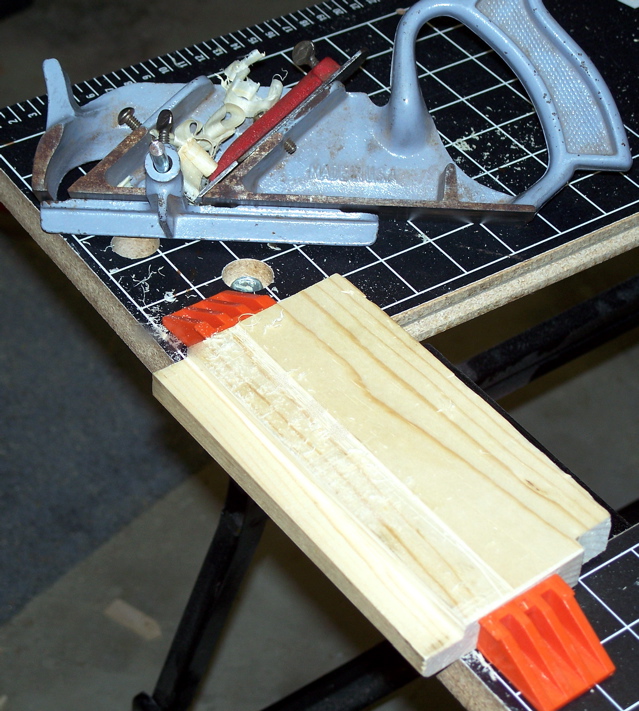
So, probably the first question on your mind is, "What the heck is a fillister, anyway?" Hah! an opportunity for pedantic over-exposition, sez I.
Most people recognize 2 kinds of planes, both meant for flattening (or reducing the thickness of) wood surfaces. There are block planes -- generally small, handle-less, and meant for use on endgrain. There are bench planes -- larger, with a handle and a knob, and meant for use on facegrain and edgegrain. Less well-known are rabbet planes. These look like small bench planes, except the blade extends across the entire sole of the plane. If you cut a "slot" into a wood surface that is across the grain, it's a "dado." If the slot's with the grain, it's a "groove." If the groove is on the edge of the surface, it's a "rabbet." Clear? (yeah, I know, I don't really get it either -- my copy of Garrett Hack's The Handplane Book is next to me as I write this.) A rabbet plane cuts -- you guessed it! -- a rabbet.
Further complicating things, some rabbet planes are equipped with a depth stop, a fence, and a nicker (a very small blade, set at the edge of the plane, that lightly scores the wood ahead of the blade; it reduces tear-out and effort). These are called Fillister planes (finally! took long enough to answer that question). The particular plane shown above is a Duplex Fillister. I assume "duplex" because of the second, forward, blade position. If the plane had only the forward position, it would be a Bullnose rabbet plane (yet another sub-specialized tool). A bullnose rabbet is for cutting a stopped rabbet. The blade is really close to the front of the tool. Basically, you figure out where you want the rabbet to stop. Then you cut at that point, chisel-out enough space for the bullnose's front, and use the plane to cut the rabbet to that space. If I move the blade from the rearward position to the forward position, this plane becomes a bullnose rabbet.
So why is it here? Well, the fence is working. It was missing the rod that supports the fence. I "replaced" it a few months ago. I went to Lowe's/Home Depot, found a long bolt with threads that fit, and cut off the bolt's head. But I wasn't happy with that solution. Last week, I discovered that Stanley sells parts via their website. I have a Stanley block plane that needed an eccentric plate (this entry is long enough -- it's the thing that controls the width of the throat). So I ordered one. And I noticed that they also sell fence-kits for a #78 Stanley Duplex Fillister. Grandpop's plane is a Craftsman, made by Stanley, and is basically a #78. I thought I might get lucky, so I ordered it, too. I didn't get lucky with the fence-kit. But it caused me to fiddle with the cut-off bolt. Enough that the plane works, now. (The eccentric plate fit perfectly. I now have a completely functional low-angle block plane.)
One other point -- a Black & Decker Workmate is completely, totally, absolutely, and without question unsuited for handplane work. It is way, way, way too light. You can't tell in the image, but the rabbet gets shallow toward the "top" end. This is because I couldn't stand over the workpiece, putting my weight on the plane. I had to stand with one foot on the Workmate, keeping it from rocking off the floor & shifting when the blade touched wood. Amazingly frustrating. I need to build a bench.

